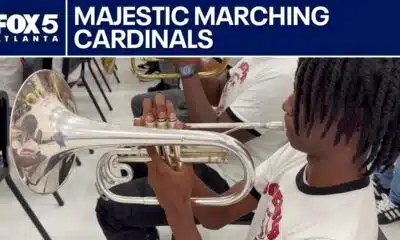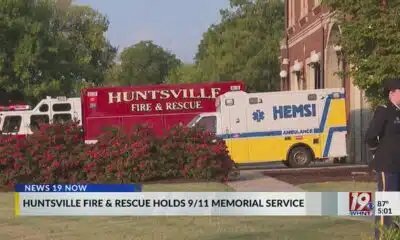News from the South - Virginia News Feed
Tougher academic standards ahead for Virginia students
Tougher academic standards ahead for Virginia students
by Nathaniel Cline, Virginia Mercury
February 27, 2025
Virginia students may soon face tougher academic benchmarks as the state aligns its performance levels with the higher standards of a national assessment.
Starting next month, the Virginia Board of Education will begin adjusting its cut scores — used to determine whether K-12 students are meeting proficiency levels — to better match the rigor of the National Assessment of Educational Progress (NAEP).
Student performance is typically categorized as “below basic,” “basic,” “proficient” or“advanced,” reflecting their knowledge and skills in core subjects.
Since 1998, Virginia has relied on its Standards of Learning (SOL) assessments to gauge proficiency in areas like reading and math. However, NAEP, a widely recognized national organization, has often been used to assess smaller student groups, such as fourth and eighth graders.
“The NAEP assessment provides a common benchmark that states can then use to look at the relative rigor of their own assessment cut scores,” said Lesley Muldoon, executive director of the National Assessment Governing Board, during a work session Wednesday.
Gov. Glenn Youngkin’s administration has frequently pointed to NAEP data to highlight what it calls the “honesty gap” — the disparity between state-level proficiency standards and the more stringent NAEP benchmarks.
Virginia’s learning recovery falls short as NAEP scores show mixed results
Between 2017-2022, Virginia’s fourth-grade reading and math results showed a staggering 40-percentage-point gap between the state’s SOL and NAEP assessments. That disparity does not provide an “accurate picture of student performance,” said Em Cooper, deputy superintendent of teaching and learning, during Wednesday’s work session.
In response, the board has begun discussing plans to revise the cut scores — the threshold for determining student proficiency — in key subjects. The effort is a cornerstone of Youngkin’s broader push to “restore excellence in education,” which includes raising standards in core subjects, increasing transparency and accountability, and overhauling the state’s assessment system.
Youngkin has argued that Virginia’s current proficiency standards are the result of the previous Board of Education lowering cut scores and altering school accreditation standards.
However, Anne Holton, a former state education secretary and an appointee of former Democratic Gov. Ralph Northam, defended the previous board’s approach. She noted that Virginia’s pass rates aligned with the NAEP’s “basic” achievement level, which reflects “partial mastery of the knowledge and skills that are fundamental for proficient work at a given grade,” according to NAEP.
The Youngkin administration, however, is pushing for Virginia to meet NAEP’s “proficient” standard — defined as a student demonstrating a deeper understanding of complex topics and the ability to apply them in real-world situations.
Board member Amber Northern, a Youngkin appointee, argued that achieving NAEP proficiency is linked to better long-term outcomes, including higher graduation rates and increased job earnings compared to students who score at the NAEP “basic” level.
“NAEP proficiency matters in terms of long-term outcomes for kids [and] I know this because I study it,” Northern said.
She dismissed political finger-pointing over the state’s current standards, urging the board to focus on the benefits of higher expectations.
“I don’t care about the politics, I don’t care about ‘well we did this, and we did this,’ … nobody knows why we are in the situation we’re in, we just know that we’re in it and we’re not about pointing fingers. What we’re about saying is, okay, this is what NAEP proficiency does for our kids, and we should actually have that as our goal to do right by them.”
But Holton pushed back, questioning whether realigning Virginia’s SOL to match NAEP would lead to actual student improvement. While she acknowledged that strong SOL and NAEP scores correlate with better outcomes, she argued that no research supports the idea that adjusting cut scores alone drives success.
“The research shows there’s no impact of realigning our cut scores,” Holton said. “We need our students to do well on the test, but where the line is is irrelevant.”
The process
Previously, cut score adjustments went through a multi-step review involving a standard-setting committee, an articulation committee, and the state superintendent before final recommendations were presented to the Board of Education.
On Wednesday, the Virginia Department of Education staff outlined the board’s new approach, which includes selecting and training committee members, assessment date, and ultimately making recommendations on cut scores.
Under the process proposal, committees will primarily consist of education experts, including teachers and instructional specialists, while the remainder will include community stakeholders such as parents and business leaders.
Educators applying to serve must complete an application demonstrating their understanding of grade level content and assessments. Community members will undergo a selection process led by the board and the governor’s office.
The committees are set to convene in late May once enough assessment data from the 2025 assessment cycle is available. Their proposed cut scores will go before the board for an initial review in June, with a final decision expected in July.
On Thursday, the board will vote on the proposed review process. If approved, the updated performance standards will not take effect until spring 2026.
GET THE MORNING HEADLINES.
Virginia Mercury is part of States Newsroom, a nonprofit news network supported by grants and a coalition of donors as a 501c(3) public charity. Virginia Mercury maintains editorial independence. Contact Editor Samantha Willis for questions: info@virginiamercury.com.
The post Tougher academic standards ahead for Virginia students appeared first on virginiamercury.com
News from the South - Virginia News Feed
Some employers take action against employees for social media comments on Charlie Kirk's death
SUMMARY: Following Charlie Kirk’s death, some Virginia employers have taken action against employees who made controversial social media comments. In healthcare and education sectors, individuals were placed on leave or terminated for remarks deemed unprofessional or supportive of violence. Riverside Walter Reed Hospital fired an anesthesiologist, and Newport News and Accomack County schools disciplined staff members. Experts highlight the blurred line between personal expression and professional conduct due to social media’s reach. William and Mary law professor Margaret Hugh emphasized that employment laws and at-will policies allow employers broad authority to act. She urges unity and respect amid heightened tensions.
Some Virginia employers are taking action against employees for social media comments made regarding Charlie Kirk’s death. A legal expert weighed in on where the line is drawn.
Subscribe: https://www.youtube.com/user/wvectv/?sub_confirmation=1
Download the 13News Now app: https://bit.ly/13NewsNowApp
Watch 13News Now+ for free on streaming: https://www.13newsnow.com/13NewsNowPlus
Check out our website: https://www.13newsnow.com/
Like us on Facebook: https://www.facebook.com/13newsnow/
Follow us on X/Twitter: https://x.com/13newsnow
Follow us on Instagram: https://www.instagram.com/13newsnow/
News from the South - Virginia News Feed
Area of interest forms in the Atlantic
SUMMARY: On September 11, 2025, Chief Meteorologist Tim Pandages reported on Hurricane Hub Live about tropical developments in the Atlantic and eastern Pacific. In the Atlantic, a low-chance area of interest near the Cabo Verde Islands may become Tropical Storm Gabrielle but requires favorable conditions. Recent tropical waves have struggled due to stable atmospheric conditions. Models show possible development east of the Leeward Islands with a likely recurving path away from Bermuda. In the eastern Pacific, Tropical Depression 13E has formed, expected to become Hurricane Mario, the season’s 8th hurricane. The Atlantic has had only one hurricane so far, Major Hurricane Aaron. Activity is expected to increase into October.
The newly formed area of interest could become Invest 92-L off the coast of Africa. Find out about that and more during tonight’s episode of Hurricane Hub LIVE! Livestream from Thursday, September 11, 2025.
Subscribe: https://www.youtube.com/user/wvectv/?sub_confirmation=1
Download the 13News Now app: https://bit.ly/13NewsNowApp
Watch 13News Now+ for free on streaming: https://www.13newsnow.com/13NewsNowPlus
Check out our website: https://www.13newsnow.com/
Like us on Facebook: https://www.facebook.com/13newsnow/
Follow us on X/Twitter: https://x.com/13newsnow
Follow us on Instagram: https://www.instagram.com/13newsnow/
News from the South - Virginia News Feed
Cat cafes, chromotherapy and pumpkin delivery: Here’s what’s new in RVA this September
SUMMARY: This September in RVA, Patch to Porch RVA delivers handpicked pumpkins from local farms, offering design, setup, and cleanup services for homes and events in Richmond, Henrico, and Chesterfield. Shore Pump introduces Beam Light Sauna, featuring infrared sauna and chromotherapy, promoting detox, skin renewal, and wellness with customizable sessions and memberships. The Fan now hosts River City’s first cat café, The Perfect Bean, combining a coffee bar with an adoptable cat lounge upstairs. Sourced locally, their drinks include seasonal, cat-themed specials. Cats come from Purring Hearts VA rescue, offering adoption opportunities, fostering community engagement and animal welfare.
What’s New in RVA is dedicated to informing you about the latest happenings in the Richmond area.
-
News from the South - North Carolina News Feed6 days ago
What we know about Charlie Kirk shooting suspect, how he was caught
-
Local News7 days ago
Russian drone incursion in Poland prompts NATO leaders to take stock of bigger threats
-
News from the South - North Carolina News Feed6 days ago
Federal hate crime charge sought in Charlotte stabbing | North Carolina
-
Our Mississippi Home5 days ago
Screech Owls – Small but Cute
-
News from the South - Arkansas News Feed6 days ago
NW Arkansas Championship expected to bring money to Rogers
-
News from the South - North Carolina News Feed6 days ago
Under pressure, some immigrants are leaving American dreams behind
-
News from the South - Alabama News Feed7 days ago
Huntsville Fire & Rescue Holds 9/11 Memorial Service | Sept. 11, 2025 | News 19 at 5 p.m.
-
Mississippi News Video6 days ago
Mississippi Science Fest showcases STEAM events, activities















































